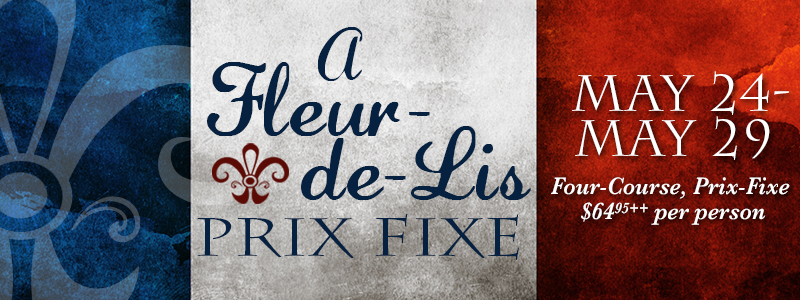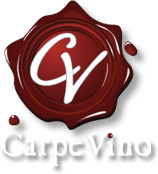
“A Fleur-de-Lis Prix Fixe” is Quintessentially French
“A Fleur-de-Lis Prix Fixe” is Quintessentially French
Other than France’s tri-color flag, there is no symbol that more closely identifies with the French culture than the iconic fleur-de-lis. And that’s why we’re calling this month’s culinary extravaganza “A Fleur-de-Lis Prix Fixe”. This title is fitting in two other ways: the term translates to “flower of the lily”, which is the birth flower of May. Also, it symbolizes French royalty, perfection, light and life.
Because of his level of expertise in French cuisine, it might be fitting for Carpe Vino’s inkless Chef Alexander to consider getting a fleur-de-lis tattooed on his forearm. Read his menu below, and you’ll likely agree.
A Fleur-de-Lis Prix Fixe begins next Tuesday at 5 p.m. and runs through Sunday (May 24 to 29). The event is comprised of four-courses, with options, 10 courses in total from which to choose. Because of the cost of ingredients and the complexity of preparations, Chef Alexander has advised that we increase the price of this event to $64.95 (plus tax and tip). The front of the house advises that because our annual French dinner is normally fully subscribed, reservations–especially Thursday through Saturday–are highly recommended.
For this menu, Chef Alexander drafted the menu explanations independently. Full disclosure: the descriptions are detailed and induce salivation. Note the liberal use of the pronoun “we”.
First Course (choice of one):
Crispy Pork and Rabbit Rilletes: (Sauternes-Poached Apricot, Frisée Salad, Moutarde Violette): A traditional French rillette is a rustic pate in which meat (traditionally duck) is seasoned and slow-cooked in fat until tender. The meat is shredded and the cooled fat is emulsified into the meat along with spices, herbs, garlic and shallots. For this dish, we’ll use pork shoulder and whole rabbits that we’ll cure and then slow-cook in duck fat until tender. The meat will be picked (bones discarded) and mixed with a little of the duck fat, herbs, garlic, shallot and mustard. In our version, we take it a step farther and form our rillettes into balls and then dip in egg wash and breadcrumbs. These morsels are fried golden brown. Alongside are apricots from Frog Hollow Farm (Brentwood, CA) poached in the famous French dessert wine, Sauternes. Served with a frisee salad and Moutarde Violette, a vibrant purple mustard from Brive, France, where mustard seeds are aged in red grape must before being processed.
Escargot Provençal (Chickpea Panisse, Green Garlic-Pernod Butter, Rouille): This is a south-of-France riff on classic Burgundy snails in garlic-parsley butter. Escargot are bathed in butter blended with spring green garlic, parsley, saffron, lemon and Pernod (an herbal, anise-scented liquor). Instead of bread to soak up the precious garlic butter, we’ll use chickpea Panisse, a Provençal dish made from cooking chickpea flour with milk or broth into a thick polenta and then chilled, which is then cut into shapes and fried. To garnish the plate we will add parsley salad and a spoon of rouille (in French, “rust”), a sauce of olive oil, saffron, garlic and red chile peppers.
Day Boat Scallop Tartare )Shaved Foie Gras, Pineapple, Vadouvan, Celery Bouillon): This dish is inspired by one I ate in Paris in 2007. . .a scallop tartare layered with raw oysters, diced apple celery and garnished with curry oil. Our version will feature raw, fresh day boat scallops from Massachusetts that will be diced, seasoned with vadouvan ( a French yellow curry powder) and topped with shavings of cured foie gras, diced pineapple and a broth made of juiced celery and pineapple. Garnished with cilantro sprouts.
Second Course (choice of one):
“Potage Parmentier” (Potato-Leek Soup, Brioche and Lobster Emulsion): This is a potato soup named after Antoine Parmentier (1737-1813), the Frenchmen who heavily promoted the potato as food fit for human consumption in France. Until then, the potato was thought to cause leprosy and was considered hog feed at best. We prepare our soup the classic way: a silky smooth purée of potatoes, leeks, fresh thyme, stock and cream. Our version features toasted cubes of buttery brioche bread and fresh chervil. An emulsion of lobster stock and cream will be spooned over the top.
Asparagus Mimosa (Farm Egg, Mâché, Breakfast Radish, Black Truffle Vinaigrette): In French cookery, “mimosa” refers to any vegetable dish garnished with diced or grated hard-cooked egg. The color of the yellow yolk with the white is said to resemble that a mimosa flower. Our salad will feature blanched California asparagus dressed in black truffle vinaigrette. Grated, hard-cooked egg, mâché lettuce and thin slices of French breakfast radish will top the asparagus with more black truffle vinaigrette drizzled around.
Main Course (choice of one):
Ora King Salmon (English Peas, Jambon de Paris, Herb Spaetzle, Riesling Beurre Blanc): This dish takes its inspiration from the region of Alsace, where France shares a border with Germany. Through time and two World Wars, this fertile land has changed hands between the two countries. As you might expect, the food and wine culture in Alsace is very similar to its northern neighbor. We sourced Ora King Salmon (a sustainably farmed product from New Zealand) and pan roast; it rests on a seasonal mix of English peas, sliced spring onion, diced Jambon de Paris (an unsmoked cured ham) and herb Spaetzle, little egg noodles made with chopped parsley, chervil, tarragon and chives. Finally, we will sauce the plate with a Beurre blanc( butter sauce) made from a reduction of Riesling wine, shallots, peppercorns and finished with copious amounts of butter.
Roast Leg of Lamb “Bretonne” (Buckwheat, Artichokes, Nettles and Rhubarb Aigre Doux): The coast of Brittany is famous for its lamb. The animals graze solely on salt marsh grasses resulting in meat with a very distinctive flavor. Our leg of lamb will be sourced locally from Dixon but will be deboned, tied, and slow roasted with coarse salt and herbs in order to mimic the flavor naturally acquired by the Bretonne lamb. Buckwheat is one of Brittany’s most important crops, used most often in the famous crepes found all over the region. We will forgo the crepes and pair the slices of roasted lamb with whole buckwheat cooked risotto style until creamy, roasted artichokes, wilted nettles (a foraged green) and rhubarb aigre doux, French for “sweet and sour”. The rhubarb will be poached in sugar and red wine vinegar.
Duck Breast Aux Cerises (Bing Cherry, Baby Turnip, Hazelnut Aillade): Roasted duck with sour cherries flambéed with brandy is another haute cuisine classic. We source our duck breast from Grimaud Farms in Stockton. After rendering the skin crispy and cooking to medium rare, the breast is sliced and glazed with local bing cherries cooked with brandy, sugar and reduced chicken stock. The duck will be paired with glazed baby turnips and a hazelnut aillade, a condiment of hazelnuts crushed with garlic, hazelnut oil and cream.
Dessert (choice of one):
Fromage Blanc Bavarois (Strawberry, Pistachio, Lavender Tuile): Fromage blanc is a very simple, fresh and creamy cows milk cheese. We source ours locally from Orland creamery in Orland, CA. A bavarois is a mousse with gelatin added to give extra structure. For this dessert, we whip fromage blanc, egg yolks and sugar, then fold in whipped cream to lighten the mix. Gelatin is added and then chilled. Served with macerated local strawberries, pistachios and a Tuile cookie scented with fresh lavender.
Dark Chocolate-Chambord Torte (Ganache, Olallieberry, Creme Fraiche): This is a classic flourless torte, very rich and velvety, with the added interest of Chambord, a French blackberry liqueur baked in. The torte is made of whipped whole eggs with sugar, whipped cream and melted chocolate all delicately folded together and baked just until set. The chilled torte is glazed with chocolate ganache; garnished with olallieberries(a blackberry-loganberry cross) from our own Four Tines Farm to add a perfect tart balance and whipped Crème Fraiche to add a creamy note to the dish.
